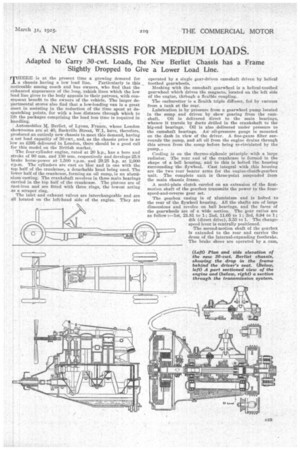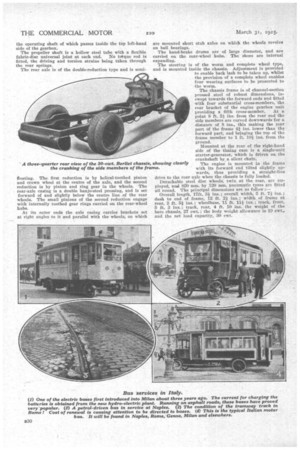A NEW CHASSIS FOR MEDIUM LOADS.
Page 13

Page 14

If you've noticed an error in this article please click here to report it so we can fix it.
Adapted to Carry 30-cwt. Loads, the New Berliet Chassis has a Frame Slightly Dropped to Give a Lower Load Line.
THERE is at the present time a growing demand for a chassis having a low load line. Particularly is this noticeable among coach and bus owners, who find that the enhanced appearance of the long, rakish lines which the low load line gives to the body appeals to their patrons, with consequent benefit to the owners of the vehicle. The larger departmental stares also find that .a low-loading van is a great asset in assisting in the reduction of the time spent at despatching points, for with a less distance through which to lift the packages comprising the load less time is required in handling.
Automobiles M. Berliet, of Lyons, France. whose London showrooms are at 40, Saekville Street, W.1, have, therefore, produced an entirely new chassis to meet this demand, having a net load capacity of 30 cwt., and, as the chassis price is as low as £395 delivered in London, there should be a good call for this model on the British market.
The four-cylinder engine, rated at 20 h.p., has a bore and stroke of 90 mm. and 130 mm. respectively and develops 25.8 brake horse-power at 1,500 r.p.m. and 29.25 h.p. at 2,000 r.p.m. The cylinders are cast en bloc and in one with the top half of the crankcase, a detachable head being used. The lower half of the crankcase, forming an oil sump, is an aluminium-casting, The crankshaft revolves in three main bearings carried in the top half of the crankcase. The pistons are of cast-iron and are fitted with three rings, the lowest acting as a scraper ring.
The inlet and exhaust valves are interehangeahle and are all located on the left-hand side of the engine. They are operated by a single gear-driven camshaft driven by helical toothed gearwheels.
Meshing with the camshaft gearwheel is a helical-toothed gearwheel which drives the magneto, located on the left side of the engine, thrbugh a flexible coupling.
The carburetter is a Zenith triple diffuser, fed by vacuum from a tank at the rear.
Lubrication is by Pressure from a gearwheel pump located in the sump and driven by skew gearing from the camshaft. Oil is delivered direct to the main bearings, whence it travels by ducts drilled in the crankshaft to the big-end bearings. Oil is also delivered under pressure to the camshaft bearings. An oil-pressure gauge is mounted an the dash in view of the driver. A fine-gauze filter surrounds the pump, and all oil from the engine drains through this screen from the sump before being re-circhlated by the pump..
Cooling is on the thermo-siphonie principle with a large radiator. The rear end of the crankcase is formed in the shape of a hell housing, and to this is bolted the housing surrounding the flywheel. Cast integral with this housing are the two rear bearer arms for the engine-clutch-gearbox unit. The complete unit is three-point suspended from the main chassis frame.
A multi-plate clutch carried on an extension of the firstmotion shaft of the gearbox transmits the power to the fourspeed-and-reverse gear set.
The gearbox casing is of aluminium and is bolted to the rear of the flywheel housing. All the shafts are of large dimensions and revolve on ball bearings, and the faces of the gearwheels are of a wide section. The gear ratios are as follow :-1st, 21.81 to 1; 24d, 11.05 to 1; 3rd, 8.94 to 1; 4th (direct drive), 5.55 to 1. The changespeed lever is centrally positioned.
The second-motion shaft of the gearbox is extended to the rear and carries the drum of the internal-expanding foatbrake. The brake shoes are operated by a cam,
the operating shaft of which passes inside the top left-hand side of the gearbox.
The propeller shaft is a hollow steel tube with a flexible fabric-disc universal joint at each end. No toque rod is fitted, the driving and torsion strains being taken through the rear springs.
The rear axle is of the double-reduction type and is semi floating. The first reduction is by helical-toothed pinion and crown wheel at the centre of the axle, and the second reduction is by pinion and ring gear in the wheels. The rear-axle casing is a double banjo-steel pressing, and is set forward of and slightly below the centre line of the rear wheels. The small pinions of the second reduction engage with internally toothed gear rings carried on the rear-wheel hubs.
At its outer ends the axle casing carries brackets set at right angles to it and parallel with the wheels, on which are mounted short stub axles on which the wheels revolve on ball bearings.
The hand-brake drums are of large diameter, and are carried on the rear-wheel hubs. The shoes are internal expanding.
The steering is of the worm and complete wheel type, and is mounted inside the chassis. Adjustment is provided to enable back lash to be taken up, whilst the provision of a complete wheel enables four wearing surfaces to be presented to the worm.
The chassis frame is of channel-section pressed steel of robust dimensions, in. swept towards the forward ends and fitted with four substantial cross-members, the rear bracket of the engine gearbox unit
providing a fifth cross-member. At a point 8 ft. 21 ins, from the rear end the side members are curved downwards for a distance of 3 ins., this making the rear part of the frame 41 ins, lower than the forward part, and bringing the top of the frame member to 1 ft. 10i ins, from the ground.
Mounted at the rear of the right-hand side of the timing case is a single-unit starter-generator, which is driven on the crankshaft by a silent chain.
The engine is mounted in the frame with its forward end tilted slightly upwards, thus providing a straight-line drive to the rear axle when the chassis is fully loaded.
Detachable steel disc wheels, twin at the rear, are employed, awl 826 mm. by 120 mm. pneumatic tyres are fitted all round. The principal dimensions are as follow:—
Overall length, 17ft. 3 ins.; overall width, 5 ft. 71 ins.; dash to end of frame, 12 ft. 21 ins.; width of frame at rear, 3 ft. 51 ins.; wheelbase, 11 ft. 111, ins.; track, front, 5 ft. 3 ins.; track, rear, 4 ft. 10 ins. the weight of the bare chassis, 27 cwt.; the body weight allowance is 10 cwt., and the net load capacity, 30 cwt.




























